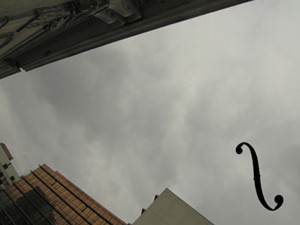Simon Gush | 4 For Four
05 Jun - 22 Aug 2010
SIMON GUSH | 4 FOR FOUR
A speculative montage for David Oistrakh and Sergei Prokofiev
05.06... 22.08.2010
This summer, the Kunst Nu rooms at the S.M.A.K. will be occupied by the South African artist Simon Gush (b. 1981). He works across a number of mediums including video, sculpture and performance.
4 for Four comprises of a video installation in which four videos attempt to examine the complexities of speaking politically or, in other words, speaking for more than oneself. Through his work, Simon Gush attempts to continually rehearse this act of articulation and is convinced that artists should adopt a specific social ‘position’. Gush believes that, very often, the most effective way to communicate is not directly but through allusion and rhetorical devices such as metaphor, metonymy and catachresis. It is the anecdotal and minor ‘details’ that fascinate him most. It is through these elements that he believes one can most effectively enter into wider debates.
4 for Four is inspired by the relationship between the virtuoso Russian violinists David Oistrakh and Sergei Prokofiev (1981-1953), one of the most important Russian composers of the 20th century. It will comprise of a video installation in four sections. In the first video a performance of Prokofiev’s 1st Violin Sonata (1946), the second Gush depicts the sky above the Potemkin Stairs, a reference to Sergei Eisenstein’s, film Battleship Potemkin (1925). The third and fourth screens will show a re-enactment of David Copperfield’s illusion in 1986, where he walked through the Great Wall of China, and an age-old, Norwegian glacial landscape respectively.
What do these different stories tell us? The 4 for Four video installation is presented as a musical, visual and narrative composition comprising of four storylines that are independent and interrelated. Gush provides poetic interpretations of historical references and sets rationality and emotion dialectically opposite each other. Each section represents a detail from the main story and thus does not avoid the whole.
A speculative montage for David Oistrakh and Sergei Prokofiev
05.06... 22.08.2010
This summer, the Kunst Nu rooms at the S.M.A.K. will be occupied by the South African artist Simon Gush (b. 1981). He works across a number of mediums including video, sculpture and performance.
4 for Four comprises of a video installation in which four videos attempt to examine the complexities of speaking politically or, in other words, speaking for more than oneself. Through his work, Simon Gush attempts to continually rehearse this act of articulation and is convinced that artists should adopt a specific social ‘position’. Gush believes that, very often, the most effective way to communicate is not directly but through allusion and rhetorical devices such as metaphor, metonymy and catachresis. It is the anecdotal and minor ‘details’ that fascinate him most. It is through these elements that he believes one can most effectively enter into wider debates.
4 for Four is inspired by the relationship between the virtuoso Russian violinists David Oistrakh and Sergei Prokofiev (1981-1953), one of the most important Russian composers of the 20th century. It will comprise of a video installation in four sections. In the first video a performance of Prokofiev’s 1st Violin Sonata (1946), the second Gush depicts the sky above the Potemkin Stairs, a reference to Sergei Eisenstein’s, film Battleship Potemkin (1925). The third and fourth screens will show a re-enactment of David Copperfield’s illusion in 1986, where he walked through the Great Wall of China, and an age-old, Norwegian glacial landscape respectively.
What do these different stories tell us? The 4 for Four video installation is presented as a musical, visual and narrative composition comprising of four storylines that are independent and interrelated. Gush provides poetic interpretations of historical references and sets rationality and emotion dialectically opposite each other. Each section represents a detail from the main story and thus does not avoid the whole.

